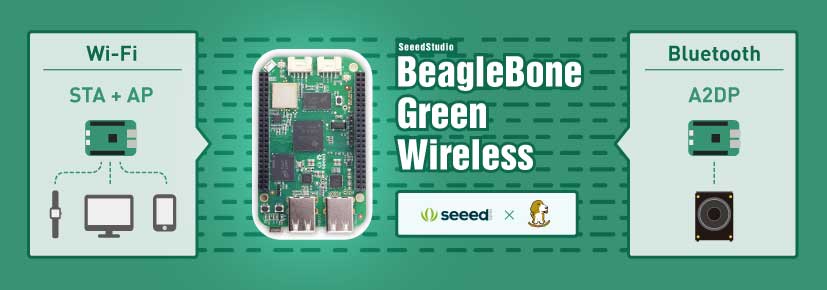SeeedStudio BeagleBone Green Wireless is a joint effort by BeagleBoard.org and Seeed Studio. Based on the open-source hardware design of BeagleBone Black, the newest BBGW has added two Grove connectors, making it easier to connect to the large family of Grove sensors. It is the first Wi-Fi + Bluetooth Low Energy (BLE) board from BeagleBone community.

DESCRIPTION
Raspberry Pi is well known as the perfect board for learning, coding, and creating your own projects. In celebration of The Raspberry Pi Foundation fourth birthday, Raspberry Pi 3 is released.
The Raspberry Pi 3 has included integrated 802.11 b/g/n wireless LAN, Bluetooth Classical and LE. You didn’t need additional peripherals to make it wireless. It is 10x the performance of Raspberry Pi 1.
What’s more, it has complete compatibility with Raspberry Pi 2, which means almost all the previous Raspberry Pi 2 accessories are compatible with Raspberry Pi 3.
SPECIFICATION
The Raspberry Pi 3 is the third generation Raspberry Pi. It replaced the Raspberry Pi 2 Model B in February 2016. Compared to the Raspberry Pi 2 it has:
- A 1.2GHz 64-bit quad-core ARMv8 CPU
- 802.11n Wireless LAN
- Bluetooth 4.0
- Bluetooth Low Energy (BLE)
Like the Pi 2, it also has:
- 4 USB ports
- 40 GPIO pins
- Full HDMI port
- Ethernet port
- Combined 3.5mm audio jack and composite video
- Camera interface (CSI)
- Display interface (DSI)
- Micro SD card slot (now push-pull rather than push-push)
- VideoCore IV 3D graphics core
The Raspberry Pi 3 has an identical form factor to the previous Pi 2 (and Pi 1 Model B+) and has complete compatibility with Raspberry Pi 1 and 2.
DOCUMENTS
Please visit our Wiki page for more information about this product. It will be much appreciated if you can help improve the documents, add more demo codes or tutorials. For technical support, please post your questions to our Forum.
NOTE
All the existing Raspberry Pi 2 accessories and kits are fully compatible with the Raspberry Pi 3.

What is new in Raspberry Pi 3
| Board | Raspberry Pi 2 Model B | Raspberry Pi 3 Model B |
|---|---|---|
| Processor | Broadcom BCM2836 | Broadcom BCM2837 |
| CPU Core | Quadcore ARM Cortex-A7, 32Bit | Quadcore ARM Cortex-A53, 64Bit |
| Clock Speed | 900 MHz | 1.2GHz (Roughly 50% faster than Pi2) |
| RAM | 1 GB | 1 GB |
| GPU | 250 MHz VideoCore IV® | 400 MHz VideoCore IV® |
| Network Connectivity | 1 x 10 / 100 Ethernet (RJ45 Port) | 1 x 10 / 100 Ethernet (RJ45 Port) |
| Wireless Connectivity | None | 802.11n wireless LAN (WiFi) and Bluetooth 4.1 |
| USB Ports | 4 x USB 2.0 | 4 x USB 2.0 |
| GPIOs | 2 x 20 Pin Header | 2 x 20 Pin Header |
| Camera Interface | 15-pin MIPI | 15-pin MIPI |
| Display Interface | DSI 15 Pin / HDMI Out / Composite RCA | DSI 15 Pin / HDMI Out / Composite RCA |
| Power Supply (Current Capacity) | 1.8 A | 2.5 A |
Board
- The size of the Pi 2 and Pi 3 boards are the same.
- There is slight change in component placement to allow addition of WiFi / Bluetooth SoC & Chip antenna in Pi 3.


System on Chip (SoC)
Broadcom BCM2837 SoC
- Application Processor
- 64 bit
- Quad Core
- 1.2 GHz
- ARM Cortex-A53 Processor (ARM V8 ISA)
- GPU
- 400 MHz
- Videocore IV Multimedia Co-Processor

Chip Antenna
A ceramic chip antenna is used by WiFi and Bluetooth 4.1 SoC BCM43438. The chip antenna moves the indicator LEDs that were present in Pi 2 to the lower side of PCB.

Repositioned LEDs
The ACT and PWR LEDs are repositioned as shown below in Raspberry Pi 3 when compared to Pi 2.

Repositioned RUN pin-header
The RUN pin-header is also repositioned
WiFi / Bluetooth SoC BCM43438
WiFi and Bluetooth 4.1 (Classic and LE) are provided by Broadcom BCM43438 chip


















دیدگاهها
هیچ دیدگاهی برای این محصول نوشته نشده است.